Friday, 3 June 2011: Antiquities and innovations
Written 7 June 2011
Friday morning, I came downstairs to find the door to the breakfast room locked. Seems the guy I notified that we would like breakfast the next morning (you have to tell them each day before 7 p.m.) forgot to order it. So the guy at reception (the manager, I think) let me in, fired up all the various drink dispensers, apologized profusely, and ran out to the nearest bakery for bread and pastries.
David joined me in pretty good time, and we set off to visit the Gallo-Roman Museum. (On the way there, I didn't know whether to be surprised or appalled to see an advertising poster in the metro touting "Les Superstars du Catch!" Yes, professional wrestling has come to France.) After the metro, we transferred to the funicular (still free with our citycards) to get up the Fourvière hill, then strolled down a couple of blocks to the entrance. Surprisingly, it was very discreetly signposted. Fortunately, we already knew where it was.
When we toured it in 1991, here's what I wrote in my diary: "What a terrific museum. Great models, zillions of inscriptions, all with translations, and huge, well preserved mozaics. I especially liked the funeral mask of a 10-year-old girl. Andy Gooday's gotta see this." I'll try to be a little more thorough this time, but really, it has to be seen to be believed. I was a little disappointed this year not to see the detailed and touching display accompanying that funeral mask; although I was watching for it, I missed it somehow.
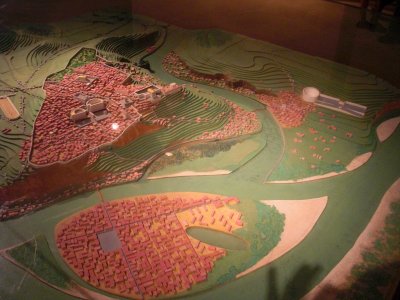
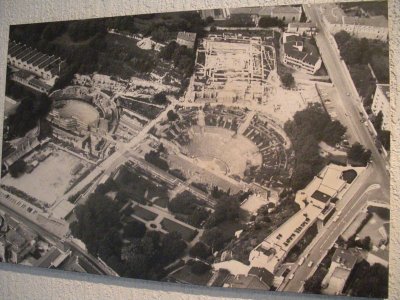 First, a little orientation. On the right, I show a photo of the museum's model of the Roman city of Lugdunum in 100-200 A.D., looking WNW The main city, currounded by a wall, is on top of the Fourvière hill. Right on the brow of the hill, overlooking the river, is the forum. Also within the walls, you can see the two semicircles of the theater and the smaller odeum. I think the bright white spot is a reflection on the model's plexiglas case. Outside the wall, at the left-hand side, is the circus, where the horse and chariot races were held. The location is speculative, from descriptions, because the actual ruins of it haven't been located yet. Across the river, on the upslope toward Croix Rousse, you can see the white circle of the amphitheater. (Note that the series of islands at the foot of the that hill has since been agglomerated into a single peninsula (running north-south), where our hotel is. The crescent-shaped cluster of buildings at the foot of Fourvière marks the location of "Vieux Lyon." At the right is a modern aerial photo of the theatre and odeum. They're open to foot traffic, but we did that last time, and this year, large parts of them were blocked off for construction, so we contented ourselves with the views of them from the museum.
First, a little orientation. On the right, I show a photo of the museum's model of the Roman city of Lugdunum in 100-200 A.D., looking WNW The main city, currounded by a wall, is on top of the Fourvière hill. Right on the brow of the hill, overlooking the river, is the forum. Also within the walls, you can see the two semicircles of the theater and the smaller odeum. I think the bright white spot is a reflection on the model's plexiglas case. Outside the wall, at the left-hand side, is the circus, where the horse and chariot races were held. The location is speculative, from descriptions, because the actual ruins of it haven't been located yet. Across the river, on the upslope toward Croix Rousse, you can see the white circle of the amphitheater. (Note that the series of islands at the foot of the that hill has since been agglomerated into a single peninsula (running north-south), where our hotel is. The crescent-shaped cluster of buildings at the foot of Fourvière marks the location of "Vieux Lyon." At the right is a modern aerial photo of the theatre and odeum. They're open to foot traffic, but we did that last time, and this year, large parts of them were blocked off for construction, so we contented ourselves with the views of them from the museum.
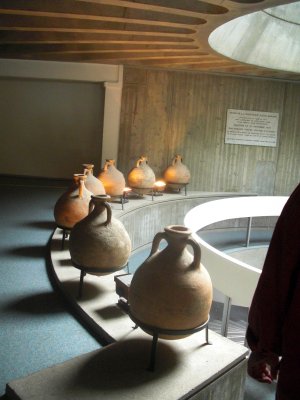
 In the aerial photo, the long white building paralleling the road in the lower right quadrant is the museum—only the roof and a little of the top floor are actually visible above ground. The rest is built into the side of the hill. At strategic points, large picture windows afford spectacular views of the theater and odeum from inside the museum. You enter at the topmost point of the museum, the corner nearest the intersection of the two roads in the aerial photo, then spiral, wind, and switchback downward very gradually until you reach the end of the exhibits at the lowest point, where you have the choice of walking back up via a "shortcut" spiral ramp (which also serves as the route for evacuation in the case of emergency) or of taking an elevator back to the top. This row of urns lines the curve at the beginning of the downward spiral. The photo on the right is a scale model of a reconstruction of the theater (or perhaps the odeum; I should have photographed the label as well).
In the aerial photo, the long white building paralleling the road in the lower right quadrant is the museum—only the roof and a little of the top floor are actually visible above ground. The rest is built into the side of the hill. At strategic points, large picture windows afford spectacular views of the theater and odeum from inside the museum. You enter at the topmost point of the museum, the corner nearest the intersection of the two roads in the aerial photo, then spiral, wind, and switchback downward very gradually until you reach the end of the exhibits at the lowest point, where you have the choice of walking back up via a "shortcut" spiral ramp (which also serves as the route for evacuation in the case of emergency) or of taking an elevator back to the top. This row of urns lines the curve at the beginning of the downward spiral. The photo on the right is a scale model of a reconstruction of the theater (or perhaps the odeum; I should have photographed the label as well).
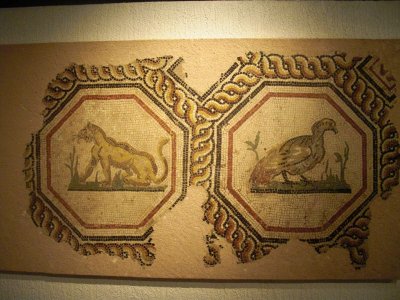
 Among museum's many splendors are a large number of beautiful mosaics, both figurative, like the one on the left, and geometric, like the one on the right. Most were floors in the Roman city and are installed on the floor in the museum. All but one are enclosed in little fences that keep you from actually walking on them, but one of the largest (maybe 7x9 meters), the "mosaic of the swastikas" (because it incorporates a couple of swastikas among its many other geometric designs) is just part of the floor of the museum, and you can walk all over it. The museum's designers cleverly left openings in the floor on upper levels through which you can look down one or two levels at mosaic floors below. In the rooms describing the theatre and odeum, huge picture windows in the hillside let you look out over the ruins.
Among museum's many splendors are a large number of beautiful mosaics, both figurative, like the one on the left, and geometric, like the one on the right. Most were floors in the Roman city and are installed on the floor in the museum. All but one are enclosed in little fences that keep you from actually walking on them, but one of the largest (maybe 7x9 meters), the "mosaic of the swastikas" (because it incorporates a couple of swastikas among its many other geometric designs) is just part of the floor of the museum, and you can walk all over it. The museum's designers cleverly left openings in the floor on upper levels through which you can look down one or two levels at mosaic floors below. In the rooms describing the theatre and odeum, huge picture windows in the hillside let you look out over the ruins.
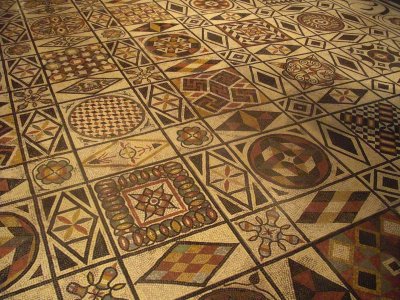
 The mosaic on the right here depicts a four-horse chariot race in the circus, complete with a crash at the lower left. In each infield rectangle a row of dolphin-shaped fountains spout water, and a figure dressed in grey-blue tends a row of rods with knobs on top used to count laps. (Note also the tall narrow pyramid in the infield. The one from the circus in Vienne, south of Lyon, is still standing.) Spectators bet not on individual chariots but on "stables," which might be represented by two or more chariots in each race. Drivers from each stable wore a different color.
The mosaic on the right here depicts a four-horse chariot race in the circus, complete with a crash at the lower left. In each infield rectangle a row of dolphin-shaped fountains spout water, and a figure dressed in grey-blue tends a row of rods with knobs on top used to count laps. (Note also the tall narrow pyramid in the infield. The one from the circus in Vienne, south of Lyon, is still standing.) Spectators bet not on individual chariots but on "stables," which might be represented by two or more chariots in each race. Drivers from each stable wore a different color.
In absolute numbers, the most common item in the museum is the block of stone with an inscription on it. They have hundreds. Many were the pedestals of statues—the statues have long disappeared (broken, stolen, whatever), but the blocks of stone were useful building material and were preserved, incorporated into later structures. They also have a good deal of statuary, both stone and bronze, and myriad tools, containers, weapons, and personal items. I especially liked a balance scale with weights in the shape of charming fat pigs of graduated sizes. A working model demonstrates how the Roman's pumped water, and a large map reveals the web of aquaducts that brought water to the city through a huge network extending in all directions for at least 50 miles around and incorporating sections that actually siphoned water up and over hills.

 For lunch, we settled at a little restaurant David had spotted in Vieux Lyon. He ordered his usual salade Lyonnaise, but I couldn't resist the "assiette du charcutier," which consisted of (left to right) hot cooked sausage slices in a red sauce (sour cherry, I think), a slice of calf's foot, boiled potato, and a fat andouillette covered with coarse-grained mustard sauce (plus salad). The sausage was straightforward Lyonnais garlic sausage, and the andouillette, although of larger diameter, was otherwise similar to many I'd encountered before. Both good. The new item was calf's foot, which I'd never had before. As you can see in the photo, it was a cross section of the nonbony part of the calf's ankle; parts of it consisted of meat, parts of fatty material, and a large part (nearest the camera) of essentially solid, gelatinous tendon and skin. I was a little leery of the tendon at first—how much of it was supposed to be edible?—but it definitely grew on me. It had the texture of a very firm gumdrop and a delicious veal flavor. I ate the whole thing, except for part of the fatty material. For dessert, which came with my lunch, I tried "tarte au pralinés," which turned out to be a wedge of pie crust topped with a thin layer of transparent, bright pink gel studded with a few almonds. I think it was supposed to be a pie version of the nubbly, pink, sugar-coated almonds the French buy and eat at fairs. I wouldn't bother to order it again.
For lunch, we settled at a little restaurant David had spotted in Vieux Lyon. He ordered his usual salade Lyonnaise, but I couldn't resist the "assiette du charcutier," which consisted of (left to right) hot cooked sausage slices in a red sauce (sour cherry, I think), a slice of calf's foot, boiled potato, and a fat andouillette covered with coarse-grained mustard sauce (plus salad). The sausage was straightforward Lyonnais garlic sausage, and the andouillette, although of larger diameter, was otherwise similar to many I'd encountered before. Both good. The new item was calf's foot, which I'd never had before. As you can see in the photo, it was a cross section of the nonbony part of the calf's ankle; parts of it consisted of meat, parts of fatty material, and a large part (nearest the camera) of essentially solid, gelatinous tendon and skin. I was a little leery of the tendon at first—how much of it was supposed to be edible?—but it definitely grew on me. It had the texture of a very firm gumdrop and a delicious veal flavor. I ate the whole thing, except for part of the fatty material. For dessert, which came with my lunch, I tried "tarte au pralinés," which turned out to be a wedge of pie crust topped with a thin layer of transparent, bright pink gel studded with a few almonds. I think it was supposed to be a pie version of the nubbly, pink, sugar-coated almonds the French buy and eat at fairs. I wouldn't bother to order it again.
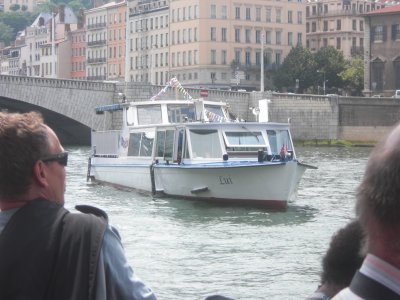
 After lunch, so that our feet could rest after the museum and the brutal cobblestones of the old town, we took a river cruise, of which we got one free with the citycards. Both the timing and our preference were in favor of the once-a-day "confluence" itinerary (down the Saône to its confluence with the Rhône at the tip of the peninsula, up the Rhône a ways, then back the same way), so we strolled across the "Passerelle [footbridge] du Palais de Justice" to the Quai des Celestins (named for the nearby Théatre des Celestins) to await its departure. The company runs two boats, Lui ("Him") and Elle ("Her"); the photo shows Lui arriving to pick us up. One of the first things we saw on the cruise was this large hotel boat, the Swiss Pearl, registered in Basel.
After lunch, so that our feet could rest after the museum and the brutal cobblestones of the old town, we took a river cruise, of which we got one free with the citycards. Both the timing and our preference were in favor of the once-a-day "confluence" itinerary (down the Saône to its confluence with the Rhône at the tip of the peninsula, up the Rhône a ways, then back the same way), so we strolled across the "Passerelle [footbridge] du Palais de Justice" to the Quai des Celestins (named for the nearby Théatre des Celestins) to await its departure. The company runs two boats, Lui ("Him") and Elle ("Her"); the photo shows Lui arriving to pick us up. One of the first things we saw on the cruise was this large hotel boat, the Swiss Pearl, registered in Basel.
 Not a lot of wildlife on the river—I saw a few mallards and, on the Rhône side, a flock of swans. I asked the captain about a sign I'd seen on the quai to the effect that it is forbidden to eat fish caught in the Saône. My question was, is the same true in the Rhône? He went into a long explanation of how the prohibition is a mere precautionary formality, that you could eat such fish four times a year without a problem but probably shouldn't eat them four times a week, just a problem of PCBs in the water, etc., etc. I repeated the question a couple of times but couldn't get a straight answer as to whether the Rhône was equally polluted. We did see many more people fishing on that side than in the Saône.
Not a lot of wildlife on the river—I saw a few mallards and, on the Rhône side, a flock of swans. I asked the captain about a sign I'd seen on the quai to the effect that it is forbidden to eat fish caught in the Saône. My question was, is the same true in the Rhône? He went into a long explanation of how the prohibition is a mere precautionary formality, that you could eat such fish four times a year without a problem but probably shouldn't eat them four times a week, just a problem of PCBs in the water, etc., etc. I repeated the question a couple of times but couldn't get a straight answer as to whether the Rhône was equally polluted. We did see many more people fishing on that side than in the Saône.
Pointed out to us on the cruise were many prominent buildings (including the churches we'd already seen, as well as two universities). I had been puzzled by the tip of the peninsula, below the Perrache train station. It was a sizeable chunk of land, right in the middle of things, served by public transport, but when I looked into hotel locations, taking into account the locations of points of interest, tourist atteractions, etc., it seemed to be desert. And it was. When the city spread to the peninsula, that area was marshy and undesirable, so all the undesirable stuff got put there—warehouses, freight depot, sewage treatment, the dump, etc. Now, plans are afoot to rehabilitate it into a major recreation and leisure destination—water park, shops, restaurants, hotels, museums (more museums; this town already has so many), etc. We saw the large white roofs of part of it from the top of Croix Rousse. Among the buildings going up is this amazing orange thing. Yes, that's a hole in the building that starts on the roof and comes out through a corner on the side. And, yes, I think it's finished and that's its final color.
On the Rhône side, we spotted a fire boat (parked at one bank), several more large hotel/cruise ships, the city's ultramodern looking indoor swimming pool (open only during three months in the summer), and the "flower tree," a whimsical piece of monumental art. I got better pictures of it later, on foot, so it will appear in a later entry.
On the stroll back to our hotel, our way was strewn with flower petals—it had been a breezy day, so it was particularly noticeable, but even on an ordinary day, the city's myriad window boxes sprinkle a steady rain of petals on the sidewalks. Every time we walked through the Place Bellecour (several times a day, since that's where both the Office de Tourisme and our nearest subway station are located), we were struck by the wonderful odor of linden ("tilleul" in French) blossoms. They smell like warm honey, and they make wonderful tea.
Dinner was at Les Loges, in the beautiful interior courtyard (now roofed with glass) of a renaissance mansion (a view of it is portrayed in a monumental mural on a building across the street), and it was great—front runner so far for best dinner of the trip.
Amuse-bouch, both: a small rectangle of coarse duck pâté encased in crispy brioche dough, accompanied by a dab of onion-sour-cherry sauce.
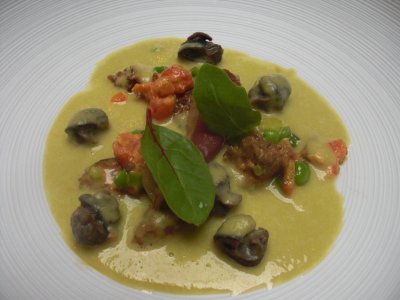
 First course, both: Snails "from Mont Blanc" in a sauce of "ail des ours" (literally "bear garlic"; Allium ursinum, called "ramsons" in the U.K., a sort of wide-leaved wild garlic, not the same, apparently, as North American "ramps") with wild mushrooms, bits of lightly smoked duck breast, green peas, and tomato. Yum!
First course, both: Snails "from Mont Blanc" in a sauce of "ail des ours" (literally "bear garlic"; Allium ursinum, called "ramsons" in the U.K., a sort of wide-leaved wild garlic, not the same, apparently, as North American "ramps") with wild mushrooms, bits of lightly smoked duck breast, green peas, and tomato. Yum!
Second course, both: Bar (sea bass), billed as "steamed" but nicely crisped on top nonetheless, with baby artichoke hearts and other vegetables in a foamy sauce supposedly infused with both cinnamon and Tonka beans, although neither was individually noticeable. Yum again!
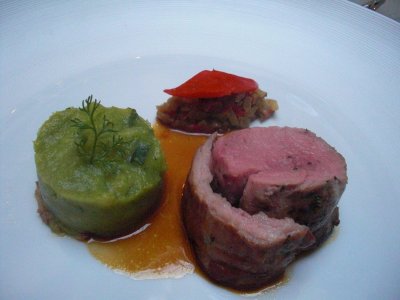
 Third course, both: Rare roast lamb from the Limousin region. The green-topped cylinder is the lamb shoulder "confit" with shallots and topped with an herb-flavored potato layer. Accompanied by a quenelle of finely diced braised fennel topped with a slice of roasted red pepper. The juice is supposedly flavored with fresh star anise, but again, the flavor was not individually identifiable—it all just came out delicious! On the side, creamy olive-oil mashed potatoes with chives.
Third course, both: Rare roast lamb from the Limousin region. The green-topped cylinder is the lamb shoulder "confit" with shallots and topped with an herb-flavored potato layer. Accompanied by a quenelle of finely diced braised fennel topped with a slice of roasted red pepper. The juice is supposedly flavored with fresh star anise, but again, the flavor was not individually identifiable—it all just came out delicious! On the side, creamy olive-oil mashed potatoes with chives.
Cheese: From the cheese trolley, David chose Roquefort, Saint Marcellin, and Chaource. I went for Chaouce, Valençay, and Saint Marcellin.
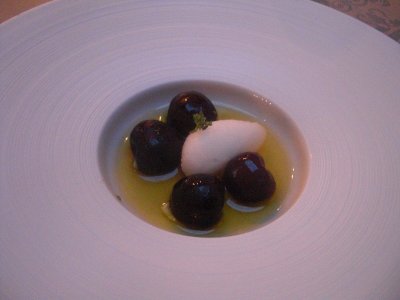
 Predessert, both: Perhaps the best dessert so far. Four fresh sweet cherries, each individually pitted and stuffed with a pistachio cream, in a pistachio-flavored syrup with a small quenelle of lime sorbet. Wow!
Predessert, both: Perhaps the best dessert so far. Four fresh sweet cherries, each individually pitted and stuffed with a pistachio cream, in a pistachio-flavored syrup with a small quenelle of lime sorbet. Wow!
Dessert, both: Supposedly, a raspberry dessert, but pretty heavy on the chocolate—layers of crisp cookie with raspberry jelly, raspberry mouse, and chocolate mousse, topped with fresh raspberries and cylinders of chocolate mousse.
Finally, mignardises: square marshmallows, tiny strawberry tarts, tiny financieère cakes, chocolate-filled chocolate macaroons. A fine dinner altogether.
previous entry
List of Entries
next entry

 First, a little orientation. On the right, I show a photo of the museum's model of the Roman city of Lugdunum in 100-200 A.D., looking WNW The main city, currounded by a wall, is on top of the Fourvière hill. Right on the brow of the hill, overlooking the river, is the forum. Also within the walls, you can see the two semicircles of the theater and the smaller odeum. I think the bright white spot is a reflection on the model's plexiglas case. Outside the wall, at the left-hand side, is the circus, where the horse and chariot races were held. The location is speculative, from descriptions, because the actual ruins of it haven't been located yet. Across the river, on the upslope toward Croix Rousse, you can see the white circle of the amphitheater. (Note that the series of islands at the foot of the that hill has since been agglomerated into a single peninsula (running north-south), where our hotel is. The crescent-shaped cluster of buildings at the foot of Fourvière marks the location of "Vieux Lyon." At the right is a modern aerial photo of the theatre and odeum. They're open to foot traffic, but we did that last time, and this year, large parts of them were blocked off for construction, so we contented ourselves with the views of them from the museum.
First, a little orientation. On the right, I show a photo of the museum's model of the Roman city of Lugdunum in 100-200 A.D., looking WNW The main city, currounded by a wall, is on top of the Fourvière hill. Right on the brow of the hill, overlooking the river, is the forum. Also within the walls, you can see the two semicircles of the theater and the smaller odeum. I think the bright white spot is a reflection on the model's plexiglas case. Outside the wall, at the left-hand side, is the circus, where the horse and chariot races were held. The location is speculative, from descriptions, because the actual ruins of it haven't been located yet. Across the river, on the upslope toward Croix Rousse, you can see the white circle of the amphitheater. (Note that the series of islands at the foot of the that hill has since been agglomerated into a single peninsula (running north-south), where our hotel is. The crescent-shaped cluster of buildings at the foot of Fourvière marks the location of "Vieux Lyon." At the right is a modern aerial photo of the theatre and odeum. They're open to foot traffic, but we did that last time, and this year, large parts of them were blocked off for construction, so we contented ourselves with the views of them from the museum.






